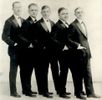Welcome to the
Original Dixieland Jazz Band®
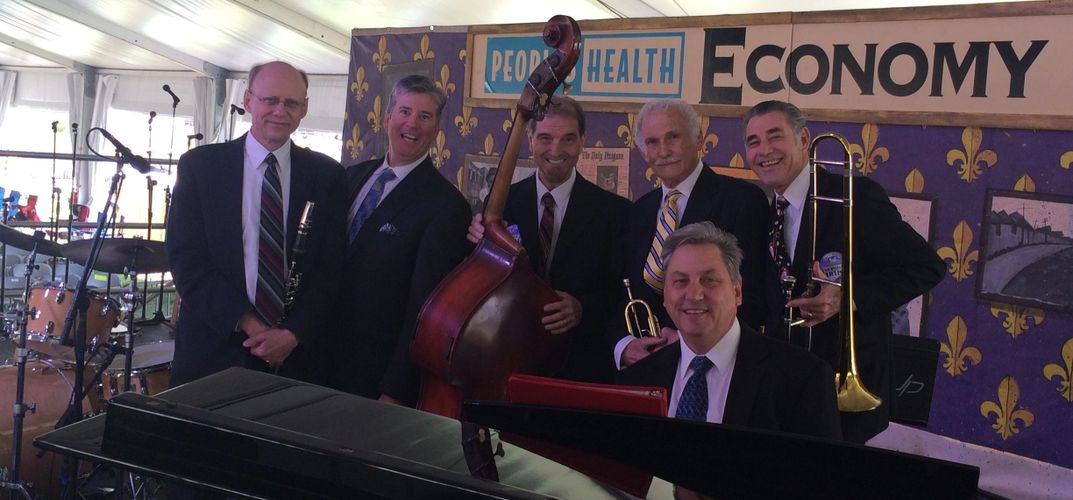
Performing: "The Music That Made New Orleans Famous”SM
Buy the music - ENJOY!
About the ODJB

Our Story
The Original Dixieland Jazz Band® performs traditional Dixieland jazz, “The Music That Made New Orleans Famous”SM producing a current sound with truly authentic New Orleans music. They are the 2nd oldest jazz band (Johnny Stein's Dixie Jass band was the 1st to use jass in a bands name in 1916) with a direct link back to 1916, securing over 100 years of tradition. The present ODJB produces a sound that is true to the original music, structure and harmony yet leap forward with innovative and creative improvised solos in authentic jazz form. In the element of New Orleans Jazz Ambassadors, they are held in the highest regard humbly performing throughout the world to sold-out audiences. This band has earned its place in history having recorded the very first jass recordings in 1917 and securing the word “jazz” as a musical genre. They were the very first “American” band to sell over a million recordings of a new “pop” music for dancing which they held for over six years. From 1917 until 1938, the ODJB recorded over one hundred and six sides (106!) more than fifty records and continues today with full albums under the direction of the original leader’s son, Jimmy LaRocca. Since 1996, the present band has performed to sold-out venues in the USA, Italy, Japan, Switzerland, Sweden, Finland, Ireland, Scotland and Brazil. Today, a family tradition continues, honoring jazz heritage from the Crescent City, New Orleans, the Big Easy! Toe tapping, hand clapping, finger snapping, happy music, the present ODJB continues to perform a famous American musical style and jazz genre that is over one hundred years old.
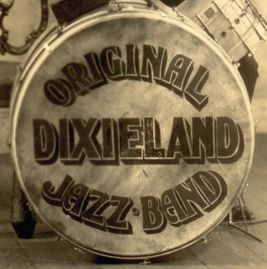
Jazz History and Today
Known as the “ODJB,” they were five “Americans” from varying ethnic backgrounds and all from the city of New Orleans. Their band was first called the Original Dixieland "Jass" Band in 1916/1917 Chicago and New York City. By November 24, 1917 in NYC, jass was replaced with the first introduction of “jazz” in recorded music and to the world on the band’s record label name and song titles.
These five band members did not come from a privileged background and on their own merits, talent, original compositions and cover songs of the day, recorded all of the most popular and influential "Jass and Jazz" recordings from 1917 to April 1923 and then through 1936. In August 1922 the New Orleans Rhythm Kings had hit recordings and in April 1923 King Oliver began his huge success. For over six years the ODJB recordings were heard around the world and hundreds, if not thousands, of future jazz musicians were influenced by their unique sound and original compositions.
The present band leader, Jimmy LaRocca, has an amazing understanding of the musical style and history of this great music. The music of the ODJB is feel good, toe tapping, happy music. Jazz is America's music. Where it came from and where it is going is an amazing journey. The ODJB is a pinnacle ensemble in the history of jazz and a proud contributor to American music and culture.
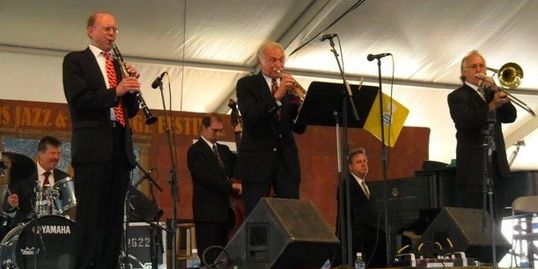
Repertoir
The present continuation of the ODJB performs all the original and cover songs the first band recorded from 1917 to 1923 such as “Tiger Rag,” “Livery Stable Blues” and “At The Jazz Band Ball” along with classic traditional New Orleans songs such as “What A Wonderful World” and many others. They also perform current original songs written and sung by Jimmy LaRocca.
ODJB Photo Gallery
New Orleans Jazz & Heritage Festival
Bookings
Hire the band to perform:
Do you want to book a show, or have questions?
Reach out and let's make music happen.
Original Dixieland Jazz Band®
CBD, New Orleans, Louisiana 70130, United States
News/Press: ODJB
Proclamation from Partanna Sicily (Italy)
Video: Original Dixieland Jazz Band®- Tiger Rag
Continuation of the Original Dixieland Jazz Band®, performing at the Kennedy Center in Washington, D.C. Jimmy LaRocca: trumpet/vocals, Tim Laughlin: clarinet, Steve Suter: trombone, Tom Roberts: piano, Al Bernard: bass and David Hansen: drum set.
ODJB Performances
No upcoming events.
Guest Performers:
The ODJB has had the honor and pleasure of having many guest performers add their talent to concerts and recordings.
A few world-class artist who have, performed, recorded and have been featured with the ODJB include:
Bob Havens, Evan Christopher, Don Vappie, Jack Mahue, Dimitri Smith, Craig Klein, Johnette Downing, Michael Supnick, Brian Ogilvie, Tim Laughlin, Tom McDermott, Michael Guma, Phil Darois and many others.
Also, ODJB members featured with other world-class artists include:
Lino Patruno, Lorenzo "Renzo" Arbore, Mauro Carpi, Tito Martino and many, many others.
Jazz History
Welcome to the ODJB jazz history and information section:
The Original Dixieland Jass Band was formed in 1916 with five talented "American" musicians from New Orleans who all travelled to and were performing in Chicago. Their early influences came from performing as sidemen with the bands lead by Papa Jack Laine, Braun’s Military Band and other Ragtime or society groups. They may have also been influence by a few other bands or groups performing in and around New Orleans during the early 1900’s. The group’s leader, Dominic James “Nick” LaRocca, was influenced by the music of the Opera House in New Orleans and John Phillip Sousa, as these were his idols. The music they performed and recorded was their own and the band made American music history. People worldwide enjoy and admire the music and accomplishments of this great American jazz band.
Below is a timeline of key important musicians/icons from New Orleans and some important information to help understand early New Orleans jazz.
George "Papa Jack" Laine (b. 1873) - not recorded. Leader of a brass band in the late 1800's and early 1900's that was a seed band for many young sidemen who became famous jazz musicians.
The Onward Brass Band (1st band): was in play from the late 1800's and early 1900's. They didn't record. This was also a seed band for many musicians who later became known as jazz musicians, such as King Oliver. The amazing drummer, Paul Barbarin lead a rendition of the band in the 1960's. There is a current band in play today that recorded in 2009.
Buddy Bolden (b. 1877) - not recorded and not a jazz musician as the musical definition term did not exist during his years as a performer. He is credited as an innovator “playing the loudest” and influenced musicians performing in the Saloons and gambling joints of the CBD area of New Orleans. Unfortunately, nobody knows how he sounded or performed as there are no recordings.
Joe "King" Oliver (b. 1885) first recorded jazz in 1923
Edward "Kid" Ory (b. 1886) first recorded jazz in 1922
Nick LaRocca (b. 1889) first recorded jass in early 1917 with his band: Original Dixieland Jass band ... the very first jass recordings for both Victor and Columbia records. The band name and song titles on their record labels changed in September 1917 from "jass" to "Jazz" and they secured the name as a musical definition term from that point forward. These first million selling records outsold any others until 1923 and most bands changed their size and sound to follow the successful recordings of the ODJB.
Freddie Keppard (b. 1889) first recorded jazz in 1926
Ferdinand "Jelly Roll" Morton (b. 1890) first recorded jazz in 1923
Sydney Bechet (b. 1897) first recorded jazz in 1924 then under his own name in 1932
Louis "Satchmo" Armstrong (b. 1901) first recorded jazz in 1923 then under his own name in 1925

Original Dixieland Jazz Band in 1922
Discography 1917 to 1936 (Original Dixieland Jazz Band)
Victor Records
1. Dixie Jass Band One Step / Livery Stable Blues #18255 February 26, 1917 (New York) (1st released jass recording – March 7, 1917 on Victor)
2. At the Jass Band Ball / Ostrich Walk #18457 March 18, 1918 (New York)
3. Skeleton Jangle / Tiger Rag #18472 March 25, 1918 (New York)
4. Bluin’ the Blues / Sensation Rag #18483 June 25, 1918 (New York)
5. Fidgety Feet / (Lazy Daddy) #18564 June 25, 1918 (New York)
Lazy Daddy #18564 July 17, 1918 (New York)
6. Mournin’ Blues / Clarinet Marmalade #18513 July 17, 1918 (New York)
7. Broadway Rose / Sweet Mama #18722 Dec 30, 1920 (New York)
8. Home Again Blues / Crazy Blues #18729 Jan 28, 1921 (New York)
9. Jazz Me Blues / (St. Louis Blues) #18772-R May 3, 1921 (New York)
St. Louis Blues #18772-R May 25, 1921 (New York)
10. Royal Garden Blues / (Dangerous Blues) #18798-R May 25, 1921 (New York)
Dangerous Blues #18798-R June 7, 1921 (New York)
Victor Cont...
11. Bow Wow Blues #18850 Dec 1, 1921 (New York)
12. Tiger Rag / Bluin’ the Blues #25403 Sept 2, 1936 (New York)
13. Clarinet Marmalade #25411 Sept 2, 1936 (New York)
14. Did You Mean It? / Who Loves You? #25420 Sept 25, 1936 (New York)
15. Ostrich Walk / (Toddlin’ Blues) #25460 Sept 2, 1936 (New York)
Toddlin’ Blues #25460 Sept 25, 1936 (New York)
16. Fidgety Feet / Veini, Veini #25668 Sept 25, 1936 (New York)
17. Old Joe Blade / Any Old Time At All #26039 Sept 25, 1936 (New York)
18. Original Dixieland One-Step / Barnyard Blues #25502 Nov 10, 1936 (New York)
19. Tiger Rag / (Skeleton Jangle) #25524 Nov 10, 1936 (New York)
Skeleton Jangle #25524 Sept 25, 1936 (New York)
20. Clarinet Marmalade / Bluin’ the Blues #25525 Nov 10, 1936 (New York)
COLUMBIA
27. Darktown Strutter’s Ball / Indiana #A-2297 Jan. 30, 1917 (New York) (2nd released jass recording) (Possibly recorded on May 31, 1917?)
28. At the Jazz Band Ball / Barnyard Blues #735 April 16, 1919 (London)
29. Ostrich Walk / Sensation Rag #736 May 12, 1919 (London)
30. Tiger Rag / Look At ‘em Doing It #748 May 19, 1919 (London)
31. Satanic Blues / Lasses Candy #759 Aug 13, 1919 (London)
32. Tell Me / Mammy O’ Mine #804 Jan 8, 1920 (London)
33. My Baby’s Arms / I’m Forever Blowing Bubbles #805 Jan 8, 1920 (London)
34. I’ve Got My Captain Working For Me Now #815 Jan 8, 1920 (London) / I Lost My Heart In Dixieland
35. Alice Blue Gown / Sphinx #824 May 14, 1920 (London)
36. Sudan #829 May 14, 1920 (London)
AEOLIAN VOCALION
21. Ostrich Walk / Tiger Rag #1206 Aug 17, 1917 (New York)
22. Barnyard Blues / (At the Jass Band Ball) #1205 Aug 17, 1917 (New York)
At the Jass Band Ball #1205 Sept 3, 1917 (New York)
23. Look At ‘em Doin It / (Reisenweber Rag) #1242 Nov 21, 1917 (New York)
Reisenweber Rag #1242 Nov 24, 1917 (New York)
24. Oriental Jass (Sudan) #1207 (12097) Nov 24, 1917 (New York)
OKEH
25. Toddlin’ Blues / (Some Of These Days) #4738-R Nov 23, 1922 (New York)
Some Of These Days #4738-R Jan 3, 1923 (New York)
26. Tiger Rag / Barnyard Blues #4841 April 20, 1923 (New York)
Additional Recordings
More recordings were completed in 1938. Then from 1996 to present, Jimmy LaRocca began recording songs/albums with his current continuation of the Original Dixieland Jazz Band®
(See the top of this page to purchase CDs or download the music)
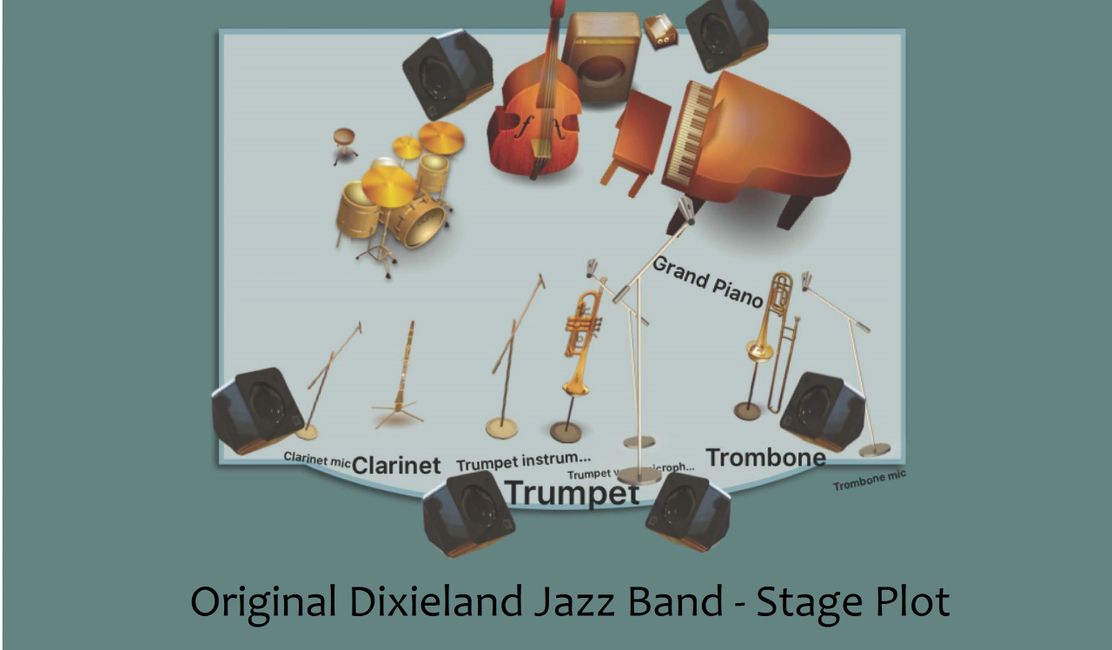
Stage Plot
Technical Information
Grand Piano
(Tuned the day of the performance)
Microphones as needed for the venue.
BASS:
Upright professional wood bass (jazz) with professional pick-up installed on the bridge. (Action can be set high but may vary ... please contact us for specific details)
BASS AMP: Professional Bass Speaker Cabinet with 10" or 12" speakers with a professional bass amp "head"
D.I. box for bass: (2) 1/4 instrument cables, (one from bass pick-up to D.I box input, one from D.I. Thru to Bass Amp Head) (1) XLR output on D.I. box to house.
DRUM SET:
One (1), four or five-piece Yamaha or similar professional jazz drum set. Remo® Coated Ambassador drum heads on snare, tom(s) and floor tom, Clear Ambassador on the bottom heads.
Bass Drum:
BEATER side (bass drum pedal side): Powerstroke® P3 or Pro "clear."
FRONT Side: Powerstroke® P3 Ebony® with 4" circle low off-set (left or right) cut-out.
CYMBALS:
Sabian, Zildjian or Istanbul Agop: Hand Hammered medium/thin professional level cymbals.
Cymbals:
14" Hi-Hats (Pair)
18" Crash/Ride - Medium
18" Crash/Ride - Heavy
20" Crash/Ride - Medium
One (1) Solid (no tilt left/right) drum throne or Guitar
MONITORS: (seven/7 total)
Two (2) front and center for trumpet/vocalist.
Five: One (1) for each other instrument: Piano, Bass, Drums, Clarinet, Trombone.
Mic boom stands: Four (4) for Trumpet (2), Clarinet and Trombone (Front-Line).
Drums: mic as needed for an acoustic sound. (We like the three mic set-up provided by Earthworks Microphones).
Bass: D.I. Box and short boom with a professional microphone pointed to the mid-section or bridge area of the bass.
Piano: mic as needed for the piano. We like to use two (2) AKG 414 or similar.
Learn More
Contact us using the form on this page. Ask us technical questions or book/hire the ODJB for a concert, Jazz Festival or similar event.
Green Room:
Fully stocked one (1) hour prior and after the event. Access to band members and the promoter only.
Provide a comfortable area with a table and chairs and, if available, sofas.
Six (6) Hand Towels (White or Black) freshly laundered, unused and clean.
Please provide a light meal for five (5), soft drinks, bottled water and coffee prior to the event and a light meal for two (2) following the event with a dessert tray for six (6).
A better than average Red Wine, White Wine and a Single Malt Scotch should be available to the band members after the performance.
Take a journey - jazz history!


